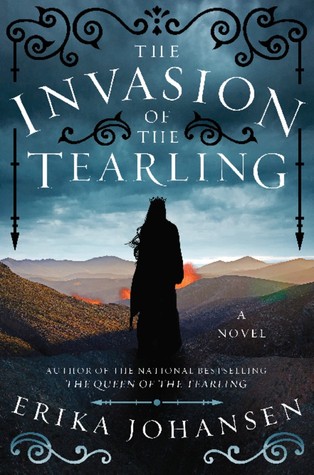The Invasion of the Tearling

Summary (from the publisher): With each passing day, Kelsea Glynn is growing into her new responsibilities as Queen of the Tearling. By stopping the shipments of slaves to the neighboring kingdom of Mortmesne, she crossed the Red Queen, a brutal ruler whose power derives from dark magic, who is sending her fearsome army into the Tearling to take what is hers. And nothing can stop the invasion.
But as the Mort army draws ever closer, Kelsea develops a mysterious connection to a time before the Crossing, and she finds herself relying on a strange and possibly dangerous ally: a woman named Lily, fighting for her life in a world where being female can feel like a crime. The fate of the Tearling —and that of Kelsea’s own soul—may rest with Lily and her story, but Kelsea may not have enough time to find out.
But as the Mort army draws ever closer, Kelsea develops a mysterious connection to a time before the Crossing, and she finds herself relying on a strange and possibly dangerous ally: a woman named Lily, fighting for her life in a world where being female can feel like a crime. The fate of the Tearling —and that of Kelsea’s own soul—may rest with Lily and her story, but Kelsea may not have enough time to find out.
Review: I received an advance reader's edition of this book from HarperCollins.
This novel is the second in the trilogy that began with The Queen of the Tearling. This novel continues Queen Kelsea's story as she fights to improve the lives of those in her kingdom and protect them from the impending invasion of the Red Queen of Mortmesne. As invasion grows closer, Kelsea is continually drawn back in time, reliving the story of Lily Mayhew, an American woman living in the tight confines of America before the Crossing and creation of the Tearling. Gradually, Kelsea learns that Lily's story and fate may explain her own life and story.
This book is a vast improvement over the first book in the trilogy. In it, the history of the Tearling is fleshed out, as is Kelsea's own character. I particularly enjoyed learning more about Lily, an American born in 2058, three hundred years before Kelsea's birth. Lily's story helps explain what went wrong in America, prompting William Tear to break away and begin a new society. In addition, this novel helps give some back story and explanation to the Red Queen and the source of her anger and bitterness.
Kelsea changes substantially over the course of this novel, as her attendants and guards continually remind her. She is no longer the innocent and plump girl who was raised in isolation and was committed to rooting out evil that she was in the first novel. Now, Kelsea has substantially developed dark magical powers and her appearance has changed drastically as she has become more and more beautiful over time. Kelsea now thinks nothing of using her abilities to violently kill a man with her mind; "she bore down harder, feeling his skin as a thick, malleable fabric of flesh that darkened and burned in the oven of her mind. His body blackened before her, the skin charring and crisping until the Queen knew that she could turn him inside out and shed his skin as easily as if he'd been a pig on a spit" (88). It's hard to know what Kelsea's future actions will be like in book three, as she is not the kind and gentle girl she once was.
Many of the themes introduced in the first novel continue to remain relevant in this book and I continue to be exasperated by most of them. There is an ongoing theme of the evil corruption of religion in this book that first appeared in the first novel. The new head of the church appears as an evil and dissolute man capable of great violence. Religion is just uniformly painted as bad, with the one exception of Father Tyler. Kelsea remains skeptical of religion and is seen rightly battling the Holy Father. Additionally, the importance of books continues to be emphasized and reiterated throughout this novel.
Similarly, there is a continued preoccupation with beauty. Kelsea is resigned to life with "a round, friendly farm girl's face, good-natured but unremarkable" yet over the course of the book her looks change and she becomes more and more beautiful. It seemed like a bit of a cop out for her to become a beautiful queen, when there was nothing wrong with her appearance before. Likewise, the Red Queen's darkest and most painful memory from childhood, "like a wound that had never been cleaned," is one where she looks at herself in a mirror, realizing that she will never be beautiful. If that's her worst memory, she's had a pretty easy life.
This book vastly exceeds the quality of the first installment in this series. However, I am skeptical of the main character's choices and ever involving personality, its deep-seated focus on outward beauty, and the seemingly gratuitous violence littered throughout the book. I was also bothered by Kelsea's casual use of cutting to relieve stress, since this is being marketed as a young adult read.
Review: 3


Comments
Post a Comment